Last week, we commenced a survey of the early years of animation’s love affair with the budding fad of exercise and fitness programs, mostly promoting the healthy values of such endeavors, despite several of its participating characters coming out of such experiences as a total wreck. By the mid 1930’s, a counter-side began to rise in several animation quarters, resulting in a short flurry of several cartoons finding their humor in onscreen exhibitions of the results of massive calorie ingestion and voracious appetites. This week’s fare will thus present the flip-side of the immortal question, “To eat or not to eat”, allowing the principal characters to obtain their fill, and hopefully audiences to obtain an equal fill of laughter.

Backtracking a bit in chronology, we have from the Van Buren studios Silvery Moon (RKO, Aesop’s Fables 1/13/33 – John Foster/Mannie Davis, dir.). One of those strange, dream-like setups that could only occur in a 1930’s cartoon, or a 1940’s Terrytoon if it was directed by John Foster. A canoeing pair of cats see the moon rise above a lake. While the male cat comments that they say the moon is made of green cheese, the girl cat, somehow all-knowing on these things, corrects him by advising that it’s made of cake, candy, and ice cream. (Who in the world starts these rumors?) The smiling, and rather impertinent, man in the moon, who has nosed his way into this conversation, decides to prove which is right, by materializing from nowhere a staircase into the heavens, and opening his mouth as a tunnel to the internal chambers of the celestial sphere. (As it appears all the surprises of this other world are buried within rather than on the surface, one can again only ask, how did anyone guess the candy, cake, and ice cream’s presence?)
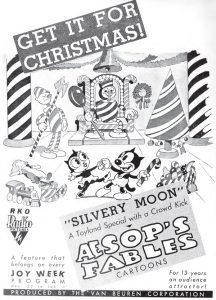
This trade advertisement via Don Yowp’s Trafaz blog – and his great post on Silvery Moon
A spread of goodies is laid out before them on a sliding conveyor belt, and the two finally sit down and consume their fill. (I wonder if the conveyor belt idea was remembered by Hanna-Barbera in an episode of the infamous “Yogi’s Ark “ series, where all the goodies of an entire planet are carted before the gang for devouring – more on this in a later chapter.) On the sidelines, a living bottle of castor oil and tablespoon spy our hero and heroine, who are now groggy from their overeating, and decide that the cats are candidates for “the treatment”. They pursue the cats, who flee to escape the fate worse than death. By means of a mere background dissolve, everyone suddenly find themselves running about the exterior surface of the moon. The two cats jump as if the gravity of the moon has no hold on them, and reach instant escape velocity, leaving the bottle and tablespoon behind. (Does gravity have more binding effect on inanimate objects, or why don’t they follow?) The cats fall back to earth, turning a few stars by their points as they pass. They make a re-entry without becoming flaming meteorites, achieving splashdown into the lake. Their canoe remains conveniently nearby, and they calmly climb back in, seeming nearly oblivious to the fact that they should be drenched. The moon bids them a musical farewell from the sky (including a grotesque close-up, clearly animated by someone entirely different than whoever is animating the long shots, which reminds one of nothing short of George Melies’ famous imagery from A Trip To the Moon (1902)), then pulls a black curtain down in front of itself for an eclipse. It’s hard to believe films could get much more bizarre – only Foster seems to have been able to top himself in this department, with such entries as “Wild Goose Chase” from the preceding year.
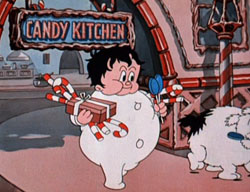 In nearly the identical vein, but with a great deal more sophistication of animation, Walter Lantz studios visited Candyland (Universal, A Cartune Classic, 2 strip Technicolor), 4/12/35). This time, however, there’s no pretense that it wasn’t all a dream. The film opens with the travels of the Sandman around the world, spreading sleep and good dreams to children of various nationalities and races (warning – some politically incorrect depictions of blacks and Chinese, possibly accounting for the infrequency with which this episode has been available to TV). An italian-dialect papa, however, is having trouble getting his “bambino” to sleep. He paces the floor as the baby wails, while the Sandman looks in at the window. Papa explains that his son wants candy, and he’s “gotta no candy”. The Sandman has a quick fix for that. He takes the child and his dog on a trip along a magical path winding its way into the clouds, to the kingdom of Candyland. He introduces them to a jolly old King, who is happy to meet any fiend of the Sandman, and who offers the visitors the run of the place. A morning parade of roly-poly elves in chef’s outfits parades down the peppermint-stick lined main thoroughfare, en route to their daily tasks in the candy kitchen. The child and dog follow them inside, witnessing morning inspection of the “troops” as their spoons are checked for spotlessness. The elves set to work on various mas-production lines and conveyor belts, turning out candy bars, jelly beans, and other treats. (The nearly flawless and elaborate animation in this, one of the most industrious Lantz projects of the 1930’s, is notably marred in one scene of a candy-bar conveyor belt, where one or two repeating cels appear over and over with an extra square of chocolate present on the belt beyond those appearing in the other drawings, causing the phantom square to continually appear and disappear from the screen.)
In nearly the identical vein, but with a great deal more sophistication of animation, Walter Lantz studios visited Candyland (Universal, A Cartune Classic, 2 strip Technicolor), 4/12/35). This time, however, there’s no pretense that it wasn’t all a dream. The film opens with the travels of the Sandman around the world, spreading sleep and good dreams to children of various nationalities and races (warning – some politically incorrect depictions of blacks and Chinese, possibly accounting for the infrequency with which this episode has been available to TV). An italian-dialect papa, however, is having trouble getting his “bambino” to sleep. He paces the floor as the baby wails, while the Sandman looks in at the window. Papa explains that his son wants candy, and he’s “gotta no candy”. The Sandman has a quick fix for that. He takes the child and his dog on a trip along a magical path winding its way into the clouds, to the kingdom of Candyland. He introduces them to a jolly old King, who is happy to meet any fiend of the Sandman, and who offers the visitors the run of the place. A morning parade of roly-poly elves in chef’s outfits parades down the peppermint-stick lined main thoroughfare, en route to their daily tasks in the candy kitchen. The child and dog follow them inside, witnessing morning inspection of the “troops” as their spoons are checked for spotlessness. The elves set to work on various mas-production lines and conveyor belts, turning out candy bars, jelly beans, and other treats. (The nearly flawless and elaborate animation in this, one of the most industrious Lantz projects of the 1930’s, is notably marred in one scene of a candy-bar conveyor belt, where one or two repeating cels appear over and over with an extra square of chocolate present on the belt beyond those appearing in the other drawings, causing the phantom square to continually appear and disappear from the screen.)
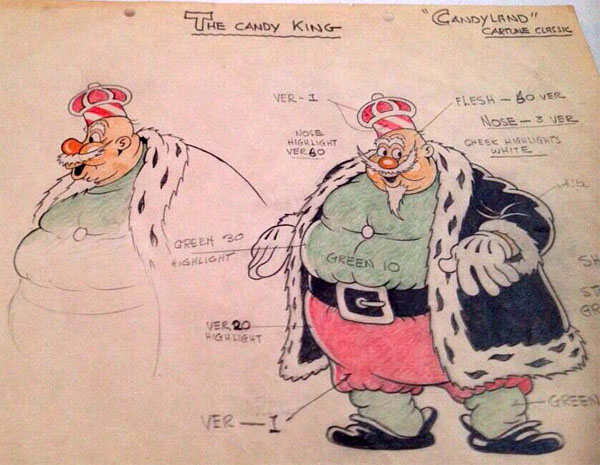
Jelly beans are produced by literally injecting real beans, fresh out of the pod, with jelly. At the end of the production line, as the beans slide down a chute into a barrel, the child and the dog begin to liberally help themselves. They also nab chocolates off the conveyor, somewhere acquire handfuls of peppermint sticks, and gumdrops flattened into shape by rolling over fluid drops of candy with a toy steam roller. The two eventually emerge from the factory well inflated like balloons, their arms still laden with a reserve supply of the day’s output. The King asks them if they have enough candy, to which they both nod. The King then tells them, open your mouth and close your eyes, and you will get a big surprise.
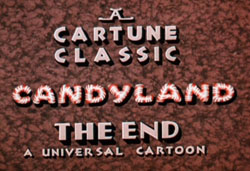 From inside his royal robes, he produces a castor oil bottle and spoon. Just before the mixture can be poured into the boy’s open mouth, his nose gets a whiff of the smell, and he peeks to see the spoon’s contents. Oh oh. The boy and the dog make tracks, with the King in pursuit down the winding road back though the clouds. Holding the spoon over the boy’s head, the King inverts it, covering the running boy in the viscous liquid. The scene dissolves, and the child is found to actually be in his own crib, half asleep, with his dog licking his face. Papa is aroused from the next bed, apparently having finally succeeded in getting Junior to sleep, and quietly scolds the dog not to wake the baby. He drops the dog outside the window into the yard, then pulls down the windowshade. Big mistake. The windowshade flips up, and the flapping noise awakens the boy. The film ends much as it began, with Papa pacing the floor with a wailing Junior, again telling him, “You want candy? I gotta no candy.”
From inside his royal robes, he produces a castor oil bottle and spoon. Just before the mixture can be poured into the boy’s open mouth, his nose gets a whiff of the smell, and he peeks to see the spoon’s contents. Oh oh. The boy and the dog make tracks, with the King in pursuit down the winding road back though the clouds. Holding the spoon over the boy’s head, the King inverts it, covering the running boy in the viscous liquid. The scene dissolves, and the child is found to actually be in his own crib, half asleep, with his dog licking his face. Papa is aroused from the next bed, apparently having finally succeeded in getting Junior to sleep, and quietly scolds the dog not to wake the baby. He drops the dog outside the window into the yard, then pulls down the windowshade. Big mistake. The windowshade flips up, and the flapping noise awakens the boy. The film ends much as it began, with Papa pacing the floor with a wailing Junior, again telling him, “You want candy? I gotta no candy.”
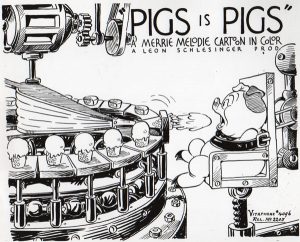 Perhaps one of the greatest animated statements of all time on the subject of overeating came from Watner’s Pigs is Pigs (Merrie Melodies, 1/30/37 – I. (Friz) Freleng, dir.). Mrs. Pig has a problem child. While her other piglets cavort and play like normal chilfren, Piggy spends the entiire afternoon daydreaming about all varieties of food he would like to be eating. Mama sets out a freshly-baked pie in the window to cool, and Piggy swipes it, spinning it on one finger so that he can systemativally consume it as it spins. A second pie goes in the window, but Piggy is caught in the act of repeating the crime, with Mama grabbing the pie away, causing Piggy to bite down upon his own fingers. At the dinner table, Piggy pulls a neat trick by tying the loose ends of each of his siblinhs’ spaghetti dinner to each other, and the leading end to the strands in his own plate. When he begins slurping down his portion, he takes along the entire plates of everyone else.
Perhaps one of the greatest animated statements of all time on the subject of overeating came from Watner’s Pigs is Pigs (Merrie Melodies, 1/30/37 – I. (Friz) Freleng, dir.). Mrs. Pig has a problem child. While her other piglets cavort and play like normal chilfren, Piggy spends the entiire afternoon daydreaming about all varieties of food he would like to be eating. Mama sets out a freshly-baked pie in the window to cool, and Piggy swipes it, spinning it on one finger so that he can systemativally consume it as it spins. A second pie goes in the window, but Piggy is caught in the act of repeating the crime, with Mama grabbing the pie away, causing Piggy to bite down upon his own fingers. At the dinner table, Piggy pulls a neat trick by tying the loose ends of each of his siblinhs’ spaghetti dinner to each other, and the leading end to the strands in his own plate. When he begins slurping down his portion, he takes along the entire plates of everyone else.
That night, as everyone else sleeps, Piggy lies awake, wishing in his mind for more of his favorite foods. He begins to nod off, and the background dissolves, as he suddenly finds himself outside the door of a strange house. The door opens, and he is invited in by a lean man in scientific labcoat (with an unexplained recurrent case of hiccups). The scientist has learned of Piggy’s liking for food, and invites him to stay for pies and cakes. He brings him to a table laden with food, and bids him to sit down in a nearby chair. Careful, it’s a trap! Straps appear to bind Piggy’s arms and torso to the chair, while a metal clamp grabs hold of his snout, connecting it to a mechanical arm which can open and close Piggy’s mouth against his will. A sequence commences straight out of a child’s worst nightmares. The chair descends into a huge subterranean laboratory, where the scientist, now obviously mad, vows, “So it’s food you want. We’ll give you plenty of it!” Pulling a wide array of levers, he sends the chair on a grand tour of the devices in the laboratory – all designed to administer force feedings. A first device mixes multiple cans of soup into a large bowl, then, as Piggy’s mouth is held open by the snout, shoots the bowl’s contents into his mouth with a spinning wheel of soup spoons. Next, mechanical hands squeeze bananas from the stalks out of their peels into Piggy’s mouth below. Olives are dispensed into Piggy’s jaws from a gumball machine. Scoops of ice cream are blown off a ring of cones into Piggy by means of a fireplace bellows in the center of the ring. A huge sandwich is constructed by mechanical hands (including one hand holding up a favorite sign gag of Freleng’s – “Hold the onions”), and the chair pushes Piggy right into the middle of the sandwich, again manipulating his upper jaw so that he is forced to chew his way through it. A device called a “Pie-o-trope” dispenses pies like an auromatic record changer on a juke box, spinning each in front of Piggy’s moving jaws to match his trick from the beginning of the picture. The scientist finally ceases when Piggy’s bloated body fills the chair. Poking Piggy’s belly like the Pillsbury dough boy, the scientist asks if he’s had enough food. “Yes, Sir”, Piggy responds. “Why, you’re not half full”, says the scientist with a sinister laugh, releasing Piggy from the straps. Piggy waddles as best he can past the scientist toward the exit door. Bur strategically placed adjacent to the exit is one last table crammed with food. Despite his inflated condition, Piggy’s instincts just can;t resist, and he snatches from the table a chicken drumstick. One bite, and BOOM! – Piggy explodes and vanishes! However, the scene dissolves, and we find Piggy safe and sound in his own bed, awakening from the dream. On the ground floor below, Mama is calling the children to come to breakfast. What lesson has Piggy learned? Absolutely nothing, as he races downstairs ahead of everyone, and ravenously gobbles down food, just the same as before!
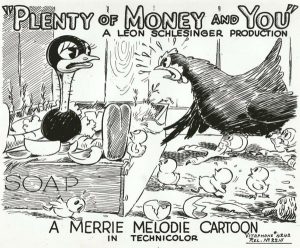 Plenty of Money and You (Warner, Merrie Melodies, 7/31/37 – I. (Friz) Freleng, dir.) – Presumably inspired by Jack King’s preceding work on “Porky’s Pet” discussed last week, Freleng brings us his own tale of an ostrich with a non-stop appetite – in this instance crossing the tale with “The Ugly Duckling”, having the ungainly bird hatch unexplainedly from the nest of a chicken. On its first outing with Mama, the bird’s cravings get it into trouble immediately. Passing a knothole in a fence, the baby ostrich pokes his head through, discovering a fish pond on the other side. The bird lowers its head into the water, and sucks up a fish. But the fish fights back to stay in the pond, dragging the bird’s head back underwater, and pulling hard enough to lift the bird’s feet off the ground on the other side of the fence, leaving him in helpless danger of drowning. Only Mama hearing the struggle saves the ostrich’s neck by pulling him back through the knothole, releasing the fish from the bird’s throat. More misadventures ensue, as the ostrich tumbles into a cellar, finding and swallowing an auto jack. A hiccup causes the hack to rise notch by notch inside the bird’s neck, then finally to release and send the bird’s head falling back to shoulder level. A chase after some worms freshly excised from the soil by Mama results in the ostrich’s unexpected encounter with a sprinkler hose, which also irrigates his insides when swallowed, sending the bird running to hide his head in the ground. But the bird has literally picked the wrong “turf”, as his head has protruded into the underground home of a weasel, who takes the bird captive for his dinner. While locked in a cage as the weasel prepares the roasting pan, the bird’s appetite remains unrestrained – first swallowing a light bulb suspended from a cord in the ceiling, depriving the weasel of light to read his recipe book. The weasel forcibly yanks the cord to retrieve the bulb from the bird’s gullet – but as the weasel returns to his cooking preparations, the ostrich spots a convenient crate of fireworks within reach (there for no apparent reason – is the 4th of July imminent?), and swallows most of its contents. The weasel places the bird in the roasting pan surrounded by vegetables, then covers him with the pan lid, placing the pan in the oven to roast while he waits. Inside, the ostrich pants from the heat, turning red in the face, then spreading to his neck, and finally his torso, where the explosive meal still rests. With a jarring blast, the oven door flies open, and the ostrich emerges, jet propelled, spitting out lit skyrockets and roman candles everywhere. The weasel’s tunnels are alive with sparks and flares, and the chicken family is thrown about above as if in the middle of an earthquake. The action finally quiets down, and a charred and battered weasel appears above ground, dragging the troublesome bird in tow, and unceremoniously throws him back to Mama, returning to his den in a huff. Mama affectionately hugs her lost ‘chick”, but only succeeds in jarring into action another volley of fireworks from the bird’s belly, this one launching the ostrich skyward, where he spits out a series of rocket flares which light the sky with the words “Eat at Sloppy Joe’s”, leaving the ostrich sitting below in a puzzled daze for the iris out.
Plenty of Money and You (Warner, Merrie Melodies, 7/31/37 – I. (Friz) Freleng, dir.) – Presumably inspired by Jack King’s preceding work on “Porky’s Pet” discussed last week, Freleng brings us his own tale of an ostrich with a non-stop appetite – in this instance crossing the tale with “The Ugly Duckling”, having the ungainly bird hatch unexplainedly from the nest of a chicken. On its first outing with Mama, the bird’s cravings get it into trouble immediately. Passing a knothole in a fence, the baby ostrich pokes his head through, discovering a fish pond on the other side. The bird lowers its head into the water, and sucks up a fish. But the fish fights back to stay in the pond, dragging the bird’s head back underwater, and pulling hard enough to lift the bird’s feet off the ground on the other side of the fence, leaving him in helpless danger of drowning. Only Mama hearing the struggle saves the ostrich’s neck by pulling him back through the knothole, releasing the fish from the bird’s throat. More misadventures ensue, as the ostrich tumbles into a cellar, finding and swallowing an auto jack. A hiccup causes the hack to rise notch by notch inside the bird’s neck, then finally to release and send the bird’s head falling back to shoulder level. A chase after some worms freshly excised from the soil by Mama results in the ostrich’s unexpected encounter with a sprinkler hose, which also irrigates his insides when swallowed, sending the bird running to hide his head in the ground. But the bird has literally picked the wrong “turf”, as his head has protruded into the underground home of a weasel, who takes the bird captive for his dinner. While locked in a cage as the weasel prepares the roasting pan, the bird’s appetite remains unrestrained – first swallowing a light bulb suspended from a cord in the ceiling, depriving the weasel of light to read his recipe book. The weasel forcibly yanks the cord to retrieve the bulb from the bird’s gullet – but as the weasel returns to his cooking preparations, the ostrich spots a convenient crate of fireworks within reach (there for no apparent reason – is the 4th of July imminent?), and swallows most of its contents. The weasel places the bird in the roasting pan surrounded by vegetables, then covers him with the pan lid, placing the pan in the oven to roast while he waits. Inside, the ostrich pants from the heat, turning red in the face, then spreading to his neck, and finally his torso, where the explosive meal still rests. With a jarring blast, the oven door flies open, and the ostrich emerges, jet propelled, spitting out lit skyrockets and roman candles everywhere. The weasel’s tunnels are alive with sparks and flares, and the chicken family is thrown about above as if in the middle of an earthquake. The action finally quiets down, and a charred and battered weasel appears above ground, dragging the troublesome bird in tow, and unceremoniously throws him back to Mama, returning to his den in a huff. Mama affectionately hugs her lost ‘chick”, but only succeeds in jarring into action another volley of fireworks from the bird’s belly, this one launching the ostrich skyward, where he spits out a series of rocket flares which light the sky with the words “Eat at Sloppy Joe’s”, leaving the ostrich sitting below in a puzzled daze for the iris out.
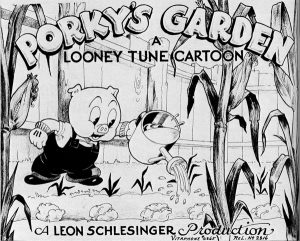 Porky’s Garden (Warner, Looney Tunes (Porky Pig), 9/11/37 – Fred (Tex) Avery, dir.) – The Podunk County Fair offers a cash prize of $2,000.00 for the largest home grown product (after taxes of $1,999, leaving a net of $1.00). For these valuable stakes, a war develops between next door neighbors Porky and an Italian stereotype rancher who raises chickens. Porky hopes to win the cash prize with his garden, using the secret ingredient of an injection into the ground of “Quick Grow Hair Tonic” – causing a full blooming garden to sprout from seed within ten seconds. (Has news of this breakthrough reached the Farmers’ Almanac?) Meanwhile, the Italian tries similar chemical warfare, with a mixture of his own consisting of every vitamin known to man poured over the chicken feed. One problem – he forgot to figure in the factor of flavor. The chickens spit it out, and hold their noses in disgust. So what to feed them? Well, how about all those nice vitamins in Porky’s freshly-grown garden? The Italian slides upwards a loose board in the property-line fence, allowing the chickens an easy entrance. They begin a systematic devouring of the whole works. One of the most creative gags has a full-grown chicken in a tug of war with a chick over a watermelon. The chicken knocks the chick away with a flick of his finger, leaving the poor hungry creature whimpering about picking on someone your own size. However, the chick encounters a spinach plant. Eating a few leaves, the chick is instantly transformed into the poultry equivalent of a miniature Popeye, complete with huge forearms, threatening and carrying out an oath to lay his opponent “among the sweet peas”. In a gag repeated in other Looney Tunes, a chicken hops on a fence near an apple tree and starts picking apples, wasting the fruit by prying each open just to get at the worms inside. Porky discovers the intrusion, and demands his neighbor make the chickens leave. The Italian feigns asking the chickens politely to leave the nice man’s garden alone, but then points out that he “cannot talk de chicken talk”. Porky looks dejectedly over his nearly barren garden as the chickens scratch up the last few remnants, but discovers a vine in the ground leading off through a hole in the opposite wall of the garden fence. Just on the other side of the hole sits a huge pumpkin! Porky grabs it, while the now observant chickens realize they overlooked something. They make a dash for the pumpkin, but Porky performs some broken-field running, dodging tackles, and carries the pumpkin safely through the garden in the manner of a football game. He trips at the last minute on his rear porch steps, but recovers the pumpkin on the front steps as it flies over the house, and races off to the fair. But the Italian’s plan has worked too, and now each of the chickens is a jumbo inflated behemoth. He marches his poultry troops off proudly to take his place in the fairground competition. Before reaching the judges’ stand, the chickens pass the sideshow exhibits, where a hawker is selling reducing pills (guaranteed to shrink an elephant to the size of a mouse, illustrated with live demonstration). A bottle spills from the hawker’s platform, and the chickens instinctively gobble up the pills as if they were chicken feed. Everyone arrives for the judging. The judges are about to give the prize to Porky’s pumpkin, but spy the even larger chickens, and pass the money sack to the Italian. But not for long. The reducing pills take effect, shrinking the chickens in reverse evolution back into the shells of eggs. The scene irises out, but reopens as two irises, with Porky reaching from one iris to the other to grab back the prize money for the film’s closing.
Porky’s Garden (Warner, Looney Tunes (Porky Pig), 9/11/37 – Fred (Tex) Avery, dir.) – The Podunk County Fair offers a cash prize of $2,000.00 for the largest home grown product (after taxes of $1,999, leaving a net of $1.00). For these valuable stakes, a war develops between next door neighbors Porky and an Italian stereotype rancher who raises chickens. Porky hopes to win the cash prize with his garden, using the secret ingredient of an injection into the ground of “Quick Grow Hair Tonic” – causing a full blooming garden to sprout from seed within ten seconds. (Has news of this breakthrough reached the Farmers’ Almanac?) Meanwhile, the Italian tries similar chemical warfare, with a mixture of his own consisting of every vitamin known to man poured over the chicken feed. One problem – he forgot to figure in the factor of flavor. The chickens spit it out, and hold their noses in disgust. So what to feed them? Well, how about all those nice vitamins in Porky’s freshly-grown garden? The Italian slides upwards a loose board in the property-line fence, allowing the chickens an easy entrance. They begin a systematic devouring of the whole works. One of the most creative gags has a full-grown chicken in a tug of war with a chick over a watermelon. The chicken knocks the chick away with a flick of his finger, leaving the poor hungry creature whimpering about picking on someone your own size. However, the chick encounters a spinach plant. Eating a few leaves, the chick is instantly transformed into the poultry equivalent of a miniature Popeye, complete with huge forearms, threatening and carrying out an oath to lay his opponent “among the sweet peas”. In a gag repeated in other Looney Tunes, a chicken hops on a fence near an apple tree and starts picking apples, wasting the fruit by prying each open just to get at the worms inside. Porky discovers the intrusion, and demands his neighbor make the chickens leave. The Italian feigns asking the chickens politely to leave the nice man’s garden alone, but then points out that he “cannot talk de chicken talk”. Porky looks dejectedly over his nearly barren garden as the chickens scratch up the last few remnants, but discovers a vine in the ground leading off through a hole in the opposite wall of the garden fence. Just on the other side of the hole sits a huge pumpkin! Porky grabs it, while the now observant chickens realize they overlooked something. They make a dash for the pumpkin, but Porky performs some broken-field running, dodging tackles, and carries the pumpkin safely through the garden in the manner of a football game. He trips at the last minute on his rear porch steps, but recovers the pumpkin on the front steps as it flies over the house, and races off to the fair. But the Italian’s plan has worked too, and now each of the chickens is a jumbo inflated behemoth. He marches his poultry troops off proudly to take his place in the fairground competition. Before reaching the judges’ stand, the chickens pass the sideshow exhibits, where a hawker is selling reducing pills (guaranteed to shrink an elephant to the size of a mouse, illustrated with live demonstration). A bottle spills from the hawker’s platform, and the chickens instinctively gobble up the pills as if they were chicken feed. Everyone arrives for the judging. The judges are about to give the prize to Porky’s pumpkin, but spy the even larger chickens, and pass the money sack to the Italian. But not for long. The reducing pills take effect, shrinking the chickens in reverse evolution back into the shells of eggs. The scene irises out, but reopens as two irises, with Porky reaching from one iris to the other to grab back the prize money for the film’s closing.
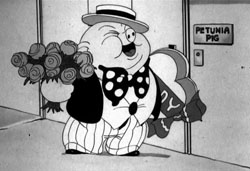 Porky’s Romance (Warner, Looney Tunes (Porky Pig), 4/3/37 – Frank Tashlin, dir.) – The classic introduction of Petunia Pig provides a character and personality much different than the comics, or the streamlined makeover given her by Bob Clampett in the late 1930’s. Unlike the rather bland “Minnie Mouse type” she eventually came to be, Tashlin’s Petunia is over-rouged in the cheeks, vain, haughty, and selfish – points not making her necessarily likeable, but at least adding facets on which to hang a story. She also possesses a little dog – a round-featured pipsqueak (possibly a cocker spaniel) with an attitude and a chip on its shoulder, likely to snap at any given time at anyone but its owner. These two don’t possess the demeanors to seem capable of real romance, but know how to put on an act when there is a prize to be had in the process. For example, Porky, all spiffy in his new straw hat, is snubbed at Petunia’s front door, as she looks through a peephole, and disdainfully comments to her dog, “Porky Pig. Pooh, pooh!” She refuses to open the door or even respond to Porky’s rings. Able to take a hint, Porky sadly and slowly walks away, broken-hearted, for home. The dog still has his eye on him out a side window, and calls his owner’s attention to the fact that behind Porky’s back, the would-be suitor was carrying a large heart-shaped box of candy. This is all the cue Petunia needs for action. In animation of blinding speed (often written up as one of Tashlin’s most striking visual achievements), she emerges from her front door in whirlwind fashion, intercepts Porky, and drags him bodily back to her home. Seizing the box of candy, she plops herself on the sofa and digs in to the box’s contents, devouring every piece at the fastest pace possible – so much so that she can’t even utters feigned “Thank you” without her speech being garbled from having her mouth full. Yet every time Porky tries to sample a piece himself, the dog growls at him menacingly. Porky finally ignores the dog’s threat, nabbing one piece from the box and sticking his tongue out at tje dog. The dog leaps into the air, and steals the candy away for himself, landing upon and crushing Porky’s straw hat on the floor. The dog further pulls a rug out from under Porky when he tries to propose (Petunia continuing to eat throughout the proposal), rendering Porky a laughing stock.
Porky’s Romance (Warner, Looney Tunes (Porky Pig), 4/3/37 – Frank Tashlin, dir.) – The classic introduction of Petunia Pig provides a character and personality much different than the comics, or the streamlined makeover given her by Bob Clampett in the late 1930’s. Unlike the rather bland “Minnie Mouse type” she eventually came to be, Tashlin’s Petunia is over-rouged in the cheeks, vain, haughty, and selfish – points not making her necessarily likeable, but at least adding facets on which to hang a story. She also possesses a little dog – a round-featured pipsqueak (possibly a cocker spaniel) with an attitude and a chip on its shoulder, likely to snap at any given time at anyone but its owner. These two don’t possess the demeanors to seem capable of real romance, but know how to put on an act when there is a prize to be had in the process. For example, Porky, all spiffy in his new straw hat, is snubbed at Petunia’s front door, as she looks through a peephole, and disdainfully comments to her dog, “Porky Pig. Pooh, pooh!” She refuses to open the door or even respond to Porky’s rings. Able to take a hint, Porky sadly and slowly walks away, broken-hearted, for home. The dog still has his eye on him out a side window, and calls his owner’s attention to the fact that behind Porky’s back, the would-be suitor was carrying a large heart-shaped box of candy. This is all the cue Petunia needs for action. In animation of blinding speed (often written up as one of Tashlin’s most striking visual achievements), she emerges from her front door in whirlwind fashion, intercepts Porky, and drags him bodily back to her home. Seizing the box of candy, she plops herself on the sofa and digs in to the box’s contents, devouring every piece at the fastest pace possible – so much so that she can’t even utters feigned “Thank you” without her speech being garbled from having her mouth full. Yet every time Porky tries to sample a piece himself, the dog growls at him menacingly. Porky finally ignores the dog’s threat, nabbing one piece from the box and sticking his tongue out at tje dog. The dog leaps into the air, and steals the candy away for himself, landing upon and crushing Porky’s straw hat on the floor. The dog further pulls a rug out from under Porky when he tries to propose (Petunia continuing to eat throughout the proposal), rendering Porky a laughing stock.
Porky attempts a suicide by hanging, but only succeeds in bringing down the tree branch to which he has tied the noose onto his own head. The knockout blow transforms him into a dream sequence similar to “Mickey’s Nightmare”, in which he imagines marriage to Petunia. But after the ceremony and honeymoon, a narrator, parodying “The March of Time” radio broadcasts, shouts the slogan, “Time Munches On!” To a rensdition of “Oh, You Beautiful Doll” played with “laughing” style brass passages, we find that Petunia’s overeating tendencies have in no manner diminished, but instead have grown with her own waistline. She now spends her day reclined in the sofa, surrounded by boxes of candy (which litter the entire house), endlessly munching away together with her dog – each of whom appear to have inflated to a weight of about 300 pounds! Porky is left to haplessly perform all the household chores single-handed, and to tend to their dozen or so infant piglets, while Petunia calls him a worm, and lays on recurring blows to Porky’s head with a rolling pin. Life lesson to the unwary what sloth and an insatiable sweet tooth may bring on.
Donald’s Ostrich (Disney/RKO, Donald Duck, 12/10/37 – Jack King, dir.) – Freshly arrived at the Walt Disney studio after his stint at Warner’s, Jack King entered on the ground floor at the dawning of Disney’s first new animated series since 1929 – a series of starring vehicles for the studio’s new up and coming celebrity – Donald Duck. Together with Carl Barks’ inspiration as writer, he and Barks strove to fashion Donald into a broader and more likeable personality, with human curiosities, frustrations and weaknesses, and able to provide a greater spectrum of reactions to situations than always reverting to his signature “Come on and fight!”
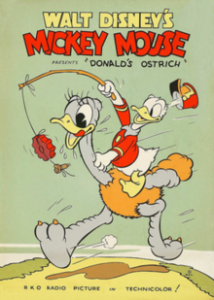 King also brought with him a reliable artist’s pen with strong draftsmanship abilities, attention to detail, and, if not a flair for exaggeration, at least an uncanny sense of neatness in ensuring that everything seemed on model. He also excelled in creating a variety of facial expressions and body-language for the duck, allowing hm to become a better actor than had generally been achieved in his previous team-ups with Mickey.
King also brought with him a reliable artist’s pen with strong draftsmanship abilities, attention to detail, and, if not a flair for exaggeration, at least an uncanny sense of neatness in ensuring that everything seemed on model. He also excelled in creating a variety of facial expressions and body-language for the duck, allowing hm to become a better actor than had generally been achieved in his previous team-ups with Mickey.
Along with these abilities, King apparently brought with him fresh memories of past projects for the WB. Among these reminiscences, King obviously housed fond recollections of his work on the ostrich featured in “Porky’s Pet”, discussed last week, and, together with Barks’ spot-gag sense for added inspiration, collaborated for the scenario for Donald’s first launch into stardom. As in the prior project, the setting continues to be a railroad. But for a change of pace, this time we don’t deal with the confrontation of a passenger and conductor. Instead, King sets up the story from a different viewpoint in the railroad inductry – that of the station master. At his headquarters in the small town of “Wahoo”, Donald attempts to run a tight ship, attending to various cargo and deliveries while enjoying some background music on a portable radio set. The music changes to a genre not of Donald’s liking – a wailing soprano aria, causing Donald to twist the dials in search of a better channel. Other competing radio fare includes a broadcast of an auto race, and a cooking show just concluding a recipe on roasting a duck. “Over my dead body”, shouts Donald, changing stations again, and finally finding a sprightly tune. As he dusts off the station magazine rack (including using his own tail feathers as a duster), the morning train approaches. Donald wheels a dolly to the platform edge for receipt of the days deliveries, calling out, “Okay. Let me have it.” He is abruptly buried in crates and suitcases, as the train passes. One of the crates, a large one reading “Use no hooks”, proves troublesome – and sprouts legs. Inside, an ostrich, bearing name tag reading “My name is Hortense. Please keep me fed and watered. P.S. I eat anything.”
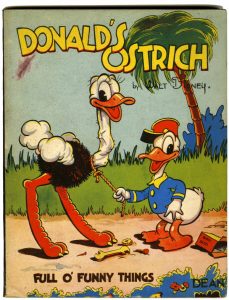 Hortense is wonderfully animated, with detail and fluidity King could only have achieved with Disney’s superlative staff and budgets. The best of his Termite Terrace boys were unlikely to have achieved the character of her effeminate flirtations with Donald, who can’t seem to get away from her kisses. The character’s exceptional design no doubt contributed to the model for the ostrich balllerinas for the soon-to-be produced “Dance of the Hours” sequence of Fantasia. She quickly proves, however, that the information on her name tag was quite accurate – by swallowing the tag itself as the first course of her feast. In struggling to free himself from Hortense’s affectionate full-body embrace, Donald stumbles into a stack of milk cans, spilling most of their contents and getting his head stuck inside one. Now Hortense’s appetite really goes to work. Exploring Donald’s magazine/souvenir stand, she finds various odd items for sale – first, a concertina (why would Donald be vending such an item?), allowing King to directly lift a gag from “Porky’s Pet” as the swallowed instrument supplies bellow pleats in Hortense’s neck. Next course is an alarm clock (Well, maybe a traveler passing through might actually have a use for this), which rings its alarm inside Hortense’s belly. Then, a nice dessert of balloons for the kiddies. These provide Hortense with a bit of confusion, as several pop before making their way entirely down her neck. A longer balloon deflates from its stem inside her throat, spinning her around during the deflation, and causing her to get the hiccups, with the accordion and alarm clock adding unique sound effects during every burp. In desperation, Hortense buries her head in the only hole available – the end of a long fire hose, and the sound of her hiccups arouses Donald, who has just freed himself from the milk cans, at the other end of the hose around the back side of the building.
Hortense is wonderfully animated, with detail and fluidity King could only have achieved with Disney’s superlative staff and budgets. The best of his Termite Terrace boys were unlikely to have achieved the character of her effeminate flirtations with Donald, who can’t seem to get away from her kisses. The character’s exceptional design no doubt contributed to the model for the ostrich balllerinas for the soon-to-be produced “Dance of the Hours” sequence of Fantasia. She quickly proves, however, that the information on her name tag was quite accurate – by swallowing the tag itself as the first course of her feast. In struggling to free himself from Hortense’s affectionate full-body embrace, Donald stumbles into a stack of milk cans, spilling most of their contents and getting his head stuck inside one. Now Hortense’s appetite really goes to work. Exploring Donald’s magazine/souvenir stand, she finds various odd items for sale – first, a concertina (why would Donald be vending such an item?), allowing King to directly lift a gag from “Porky’s Pet” as the swallowed instrument supplies bellow pleats in Hortense’s neck. Next course is an alarm clock (Well, maybe a traveler passing through might actually have a use for this), which rings its alarm inside Hortense’s belly. Then, a nice dessert of balloons for the kiddies. These provide Hortense with a bit of confusion, as several pop before making their way entirely down her neck. A longer balloon deflates from its stem inside her throat, spinning her around during the deflation, and causing her to get the hiccups, with the accordion and alarm clock adding unique sound effects during every burp. In desperation, Hortense buries her head in the only hole available – the end of a long fire hose, and the sound of her hiccups arouses Donald, who has just freed himself from the milk cans, at the other end of the hose around the back side of the building.
Donald searches for a means to scare Hortense as a hiccup remedy. Meanwhile, Hortense decides it’s mealtime again, and swallows Donald’s transistor radio. (A cute touch has the radio broadcasting a crime drama while being swallowed, with the voice of Billy Bletcher shouting to a hostage, “GET IN THERE!” just as the radio vanishes down Hortense’s throat.) Donald emerges from the station house, armed to the teeth with items to scare Hortense, but hears the radio’s sounds coming from Hortense’s innards. Prying open Hortense’s beak for a look see, Donald is again greeted by the shouting voice of Bletcher, proclaiming, “Shut that door, ya sap!” Getting the idea what has happened, Donald procures some fireplace tongs in an attempt to fish out the swallowed items from Hortense’s insides. He manages to retrieve a few, including the concertina, but not the radio. Hortense’s hiccups resume – and with each, a change of station on the radio. Hortense transforms in mode with each channel change, particularly affected by broadcasts of a prize fight, and the continued auto race, shifting her into the moves of a boxer and a racing car. As the race goes into the final lap, Donald is pursued into the station house by Hortense, who runs laps with him around and around the interior walls. The radio announder tells that one car has lost a wheel – and Hortense begins to go out of control. Donald trues to hide inside his luggage room, but Hortense bursts through the door in sync with the crash of the racer, laying waste to everything inside. Somehow, the radio is finally ejected from the force of the impact, and amidst the pile of shattered luggage, broadcasts that in spite of the crack-up, no one was hurt. “Oh, yeah?” says Donald, as he and Hortense emerge from under the luggage, both with black eyes. And to top thinhs off, now Donald has the hiccups, which continue for the iris out.
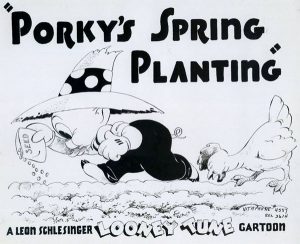 Porky’s Spring Planting (Warner, Looney Tunes (Porky Pig), 7/25/38 – Frank Tashlin, dir.) – Porky is once again in a planting mood, this time with the assistance of a bulky dog inappropriately named “Streamline”, who “talks” only through means of thought transferrence, much like Garfield or the Archies’ Hot Dog in later years. Again, his garden is under the wachful eye of chickens, but not for the purposes of winning a county fair prize. Instead, a self-enterprising rooster intends to convert the garden into his own personal business venture – a buffet restaurant for barnyard fowl, pay as you exit for what you devoured. His posted menu after scouting the terrain includes “Fruit Cocktail – Shake it down yourself and save.” “Lettuce and Gravel Salad”, and an entree of “Corn Beet and Cabbage”, with an option of “Side order of worms – 5 cents extra”. The chickens roam the rows of fresh vegetables, filling their trays with a bounty. In one scene, they approach in a row, making entire lines of vegetables disappear before them as if a living lawn mower. Porky yells at them to get out, and they retreat in reverse, “un-eating” the row which magically reappears where it was. Porky tells Streamline to do something, reminding him, “Aren’t you a watchdog?” “Sure I’m a watchdog”, replies Streamline in thought voice, “I’m full of ticks.” When all efforts to rid himself of the birds fails, Porky offer to plant the chickens a separate garden if they’ll leave his alone, but can’t strike a deal on what to plant until he reaches his package of corn seeds, to which the chickens respond en masse, ‘Oh, yeah!”
Porky’s Spring Planting (Warner, Looney Tunes (Porky Pig), 7/25/38 – Frank Tashlin, dir.) – Porky is once again in a planting mood, this time with the assistance of a bulky dog inappropriately named “Streamline”, who “talks” only through means of thought transferrence, much like Garfield or the Archies’ Hot Dog in later years. Again, his garden is under the wachful eye of chickens, but not for the purposes of winning a county fair prize. Instead, a self-enterprising rooster intends to convert the garden into his own personal business venture – a buffet restaurant for barnyard fowl, pay as you exit for what you devoured. His posted menu after scouting the terrain includes “Fruit Cocktail – Shake it down yourself and save.” “Lettuce and Gravel Salad”, and an entree of “Corn Beet and Cabbage”, with an option of “Side order of worms – 5 cents extra”. The chickens roam the rows of fresh vegetables, filling their trays with a bounty. In one scene, they approach in a row, making entire lines of vegetables disappear before them as if a living lawn mower. Porky yells at them to get out, and they retreat in reverse, “un-eating” the row which magically reappears where it was. Porky tells Streamline to do something, reminding him, “Aren’t you a watchdog?” “Sure I’m a watchdog”, replies Streamline in thought voice, “I’m full of ticks.” When all efforts to rid himself of the birds fails, Porky offer to plant the chickens a separate garden if they’ll leave his alone, but can’t strike a deal on what to plant until he reaches his package of corn seeds, to which the chickens respond en masse, ‘Oh, yeah!”
(Enjoy the Spanish dub below)
Next Time: Both the fit and the fat battle it out head to head – or is it tummy to tummy?


 Charles Gardner is an animation enthusiast who toils by day as a member of LA Law – but by nights and weekends indulges in classic jazz and ragtime as a performer; and studies classic Hollywood cartoons… maybe a little too much.
Charles Gardner is an animation enthusiast who toils by day as a member of LA Law – but by nights and weekends indulges in classic jazz and ragtime as a performer; and studies classic Hollywood cartoons… maybe a little too much.


































































































































































I wonder if Silvery Moon inspired Bob Clampett’s Porky In Wackyland?
Was that Mae Questal as the voice of the girl cat?
In the Thunderbean Thursday post about “Silvery Moon” for October 15, 2020, Steve Stanchfield said it was Margie Hines.
Thanks.
For your consideration: HOLLYWOOD DIET.
https://www.youtube.com/watch?v=QrSwFiaVNbQ
The “Hold the onions” gag wasn’t exclusive to Freleng; Jones used it in “Wackiki Wabbit”, McKimson in “French Rarebit”. Someone at Termite Terrace didn’t like onions and always said “Hold the onions!” when ordering lunch, which apparently was an endless source of mirth among his colleagues. Then in the Disney Silly Symphony “The Golden Touch”, when a starving King Midas is willing to exchange his kingdom for a hamburger sandwich, Goldie the elf laughs sardonically and asks: “With or without onions?” Walt thought that line was hilarious, but it fell flat at the premiere. Why did all these cartoonists think onions were so funny? Everyone knows they make you cry.
What a lot of gluttonous ostriches we’ve seen in this Animation Trail! You might also have mentioned “Ozzie Ostrich Comes to Town” (Terrytoons/Educational, Kiko the Kangaroo, 28/5/37 — Mannie Davis and George Gordon, dirs.), in which the titular ratite gobbles a pocket watch, the pendulum of a cuckoo clock (followed by the cuckoo), a baby bottle, a glove, a yeast cake, and ultimately a case of dynamite. This behaviour actually has a basis in reality. Ostriches are omnivorous, and in the wild they will eat practically anything that moves; but in captivity, this instinctive response means that they’ll swallow pretty much anything that’s thrown at them. Before zoos started cracking down on this sort of thing (q.v. Egghead in “A Day at the Zoo”), people used to toss candy, pennies, cigarette butts, and miscellaneous bits of garbage at the ostriches just to laugh at the silly birds as they gulped it all down. Often the poor animals would sicken and die, but back in the day, boy, was it ever funny! (Cue the usual chorus of nostalgiacs lamenting that Political Correctness has sucked all the fun out of everything.) Of course, no animals were harmed in the making of these cartoons.
However, there is one thing that all of these ostrich cartoons, including Fantasia, got wrong. If you see an ostrich with black feathers and white wing and tail plumes, like Lulu and Hortense, that means it’s a male. Female ostriches are brown.
Candyland is stunning! I would love to see a remastered version so the colors pop. And, good heavens, was whomever singing Candyland channeling Bing Crosby!
I don’t believe there has ever been a more satisfying ending to a cartoon than Porky (Porky’s Romance) abruptly zooming back in to kick Fluffnum’s butt a good one.
It might be covered in a later Trail, but “Pigs is Pigs” served as the inspiration for Homer Simpson’s ironic Hell in “Treehouse of Horror IV”.